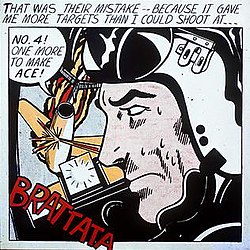Brattata
| Brattata | |
|---|---|
 | |
| Artist | Roy Lichtenstein |
| Year | 1962 |
| Movement | Pop art |
| Dimensions | 106.7 cm × 106.7 cm (42 in × 42 in) |
| Location | Tehran Museum of Contemporary Art |
Brattatais a 1962pop artpainting byRoy Lichtensteinin hiscomic bookstyle of usingBen-Day dotsand atext balloon.The work is held in the collection at theTehran Museum of Contemporary Art.It is one of several Lichtenstein works fromAll-American Men of Warissue #89, but is a reworking of its source panel.
Background
[edit]
According to theUniversity of Michigan Library,at one time the work was held in the Fischmann collection.[1]St. Louis businessman and financier, Milton Fischmann died in May 1974,[2]and the work is now in the collection of the Tehran Museum of Contemporary Art.[3]A trained draftsman and artist, Lichtenstein was aUnited States Armypilot who served inWorld War IIwithout ever seeing active combat.[4][5]His list of aeronautical-themed works is extensive. Within that genre, Lichtenstein has featured pilots situated in cockpits during air combat in many of his works, such asJet Pilot(1962),Brattata(1962),Bratatat!(1963), andOkay Hot-Shot, Okay!(1963).[6]The source ofBrattataisAll-American Men of War#89 (January–February 1962,DC Comics).[7]The same issue was the inspiration for several other Lichtenstein paintings,Okay Hot-Shot, Okay!,Blam,Whaam!andTex![8]The graphite pencil sketch,Jet Pilotwas also from that issue.[9]The pilot's mask is unbuckled, revealing the lower half of his face (as opposed toBratatat!andJet Pilotwhere only the eyes are visible).[10]Theonomatopoeiapresented graphically appears as acliché.[11]In comparison to the original Lichtenstein increased the required number of downed planes forflying acerecognition by two,[12]possibly reflecting his own training.
Critical appraisal
[edit]
The work is among those known for "bursting shapes and colors" in its graphical content and excellent sound and action in its narrative content.[13]It is one of several Lichtenstein works that depicts what one author describes as a "male violence fantasy".[14]
Original artwork artistRuss Heathhad accurately depicted the downward slantinggun sightand angled cockpitcontrol panel.Lichtenstein depicted these without any slant, making them parallel to the surface of the canvas, which in a sense makes the viewer feel as if he is taking the place of the pilot.[15]
See also
[edit]Sources
[edit]- ^"LICHTENSTEIN, ROY; Brattata; 1962".Regents of the University of Michigan.RetrievedJuly 15,2013.
- ^"Benefactor's Death Clouds Dinner Program".Sarasota Journal.RetrievedJuly 15,2013.
- ^ "Lichtensteins in Museums".LichtensteinFoundation.org. Archived fromthe originalon June 6, 2013.RetrievedJune 22,2013.
- ^ "Chronology".Roy Lichtenstein Foundation. Archived fromthe originalon June 6, 2013.RetrievedJune 9,2013.
- ^ McCarthy, David (2004).H.C. Westermann at War: Art and Manhood in Cold War America.University of Delaware Press. p. 71.ISBN087413871X.
- ^ Pisano, Dominick A., ed. (2003).The Airplane in American Culture.University of Michigan Press.p. 275.ISBN0472068334.
- ^ "Brattata".LichtensteinFoundation.org.RetrievedJune 24,2013.
- ^Armstrong, Matthew (Autumn 1990). "High & Low: Modern Art & Popular Culture: Searching High and Low".Moma.2(6).Museum of Modern Art:4–8, 16–17.JSTOR4381129.
- ^"Jet Pilot".LichtensteinFoundation.org.RetrievedJune 24,2013.
- ^Lobel, Michael (2009). "Technology Envisioned: Lichtenstein's Monocularity". In Bader, Graham (ed.).Roy Lichtenstein.MIT Press.p. 120.ISBN978-0-262-01258-4.
- ^Foster, Hal (2009). "Pop Pygmalion". In Bader, Graham (ed.).Roy Lichtenstein.MIT Press.p. 157.ISBN978-0-262-01258-4.
- ^Madoff, Steven Henry, ed. (1997).Pop Art: A Critical History.University of California Press.pp. 204–5.ISBN0-520-21018-2.
- ^ Johnson, Ellen H. (1995).Modern Art and the Object: A Century of Changing Attitudes.Westview.p. 178.ISBN0064302261.
- ^ Zinman, Toby Silverman, ed. (1991).David Rabe: A Casebook.Garland.p. 36.ISBN0824070798.
- ^ Lobel, Michael (2002).Image Duplicator: Roy Lichtenstein and the Emergence of Pop Art.Yale University Press.pp. 121–122.ISBN0300087624.
